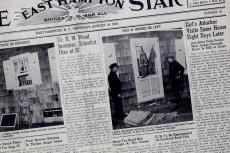An excellent Covid vaccination question came to me this week from a reader inquiring if a third dose was recommended after receiving an mRNA booster vaccine (such as Moderna or Pfizer) following the Johnson and Johnson single dose.
Right now, there is no indication for individuals who are not immunocompromised to receive an additional booster vaccination in the above scenario, although multiple reports have indicated that the potential need for additional vaccinations is a source of ongoing study. In this setting, the term “booster” refers to a third dose of either Moderna or Pfizer after having previously completed the initial two-dose series (individuals are eligible for a booster five months after their second dose), or a second vaccination with the Moderna, Pfizer, or Johnson and Johnson two months or more after having received the initial single-dose Johnson and Johnson vaccination.
With regards to the Johnson and Johnson vaccination series, the Centers for Disease Control recently announced a preference for mRNA booster vaccinations for those who received the single-dose Johnson and Johnson vaccine. This reflected several issues, chief among them that there is a very slightly increased risk of blood clots (as I’ve written about previously) with the Johnson and Johnson vaccines and that receiving a booster dose of an mRNA vaccine after the Johnson and Johnson vaccine led to notably high antibody levels.
To the point of this reader’s question about booster vaccinations after Johnson and Johnson and their effectiveness, this high antibody level seen after a booster with an mRNA vaccine was noted to be markedly higher with Moderna after Johnson and Johnson as compared to a dose of the Pfizer vaccine. However, those data appear to have reflected a full dose of the Moderna vaccine as opposed to the half dose as booster that has been approved by the federal Food and Drug Administration for booster vaccinations, so some have posited that the actual real-world efficacy is likely of a Moderna or Pfizer booster following the initial Johnson and Johnson shot to be similar.
As I discussed in last week’s column, while we do have effectiveness data for booster vaccinations that underscore the overwhelming importance of receiving a booster if eligible, I have not yet been able to find any specific published data that compare “real-world” efficacy of mixing and matching mRNA vaccines after an initial Johnson and Johnson vaccine, particularly in the context of the recent Omicron surge (although it is to be assumed that studies examining this are ongoing).
However, as noted above, high levels of neutralizing antibodies have been shown to be generated in patients receiving an mRNA vaccine after first getting the Johnson and Johnson vaccine, and this appears to correlate well with the efficacy seen in the overall “real world” effectiveness of booster vaccinations that I wrote about last week.
For now, people who are not immunocompromised and have received a booster dose as described above can rest assured that they have the most protection possible from vaccines right now.
However, people who are moderately to severely immunocompromised are eligible to receive a fourth dose (or third, if the first was a Johnson and Johnson) five months after their third dose, according to an update the C.D.C. posted on their website on Jan. 7.
Some reports have indicated that some people have reported difficulty in acquiring these fourth shots, so anybody who thinks they fit the criteria of being moderately to severely immunocompromised should discuss their options with
their physician, and locally can get the shots at Stony Brook Southampton Hospital’s vaccination site at the Greek Orthodox Church of the Hamptons.
—
Joshua Potter, D.O., a physician with Stony Brook Southampton Hospital’s Meeting House Lane Medical Practice, oversees the practice’s Shelter Island office. He specializes in family and neuromusculoskeletal medicine. Opinions expressed in this column are his personal and professional views and not necessarily those of his employer.



